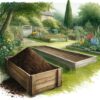1-2-3 Guide to the foundations of Garden Design
Embarking on the journey of garden design can be both exhilarating and daunting, especially for those new to the art of landscaping. This comprehensive guide is crafted to ease you into the world of gardening, offering essential tips and tricks to transform any outdoor space into your personal Eden. Whether you possess a sprawling backyard or a cozy balcony, our Garden Design 101 will walk you through the vital steps of creating a vibrant, flourishing oasis. From understanding the nuances of your space to selecting the perfect plants and implementing sustainable practices, we’ve got you covered. So, grab your gardening gloves, and let’s delve into the art of crafting a garden that not only blooms with life but also resonates with your personal style and environmental consciousness.
Understanding Your Space
The first step in creating your garden is a thorough assessment of your outdoor space. This stage is crucial in laying the groundwork for all subsequent gardening decisions. It involves observing how sunlight travels across your area, understanding the type of soil you have, and considering the local climate and hardiness zone. These factors determine which plants will thrive in your garden, how you should arrange your space, and what additional adjustments might be necessary to ensure your garden’s success.
- Sunlight Monitor the patterns of sunlight and shade in your garden throughout the day.
- Soil Type Test your soil to determine its composition and how it may affect plant growth.
- Climate and Hardiness Zone Choose plants that are appropriate for your area’s weather conditions and temperature extremes.
Planning Your Layout
Designing the layout of your garden is a blend of creative expression and practical planning. This step transforms your vision into a structured design, considering both the aesthetics and functionality of the space. Here, you’ll make decisions about the placement of plants, the creation of paths and walkways, and the incorporation of different heights and textures to create a visually appealing and easy-to-navigate garden.
- Functionality Determine the primary purpose of your garden areas (e.g., relaxation, vegetable growing).
- Paths and Walkways Design paths to guide movement and protect your plants.
- Height and Texture Use plants of varying heights and textures to create visual interest.
Choosing Plants
Selecting the right plants is at the heart of garden design. This process is about more than just picking your favorites; it involves considering the specific needs and compatibility of different plant species. By choosing a mix of perennials and annuals, coordinating colors, and considering the maintenance needs, you can create a garden that is vibrant, diverse, and manageable.
- Mix Perennials and Annuals Balance long-lasting perennials with the seasonal beauty of annuals.
- Color Coordination Plan your garden’s color palette for visual harmony.
- Maintenance Needs Choose plants that fit your lifestyle and gardening capacity.
Adding Personal Touches
Your garden is an extension of your home and personality, so infusing it with personal touches is key. This can range from artistic elements like sculptures and wind chimes to functional features like comfortable seating and effective lighting. These additions not only enhance the beauty of your garden but also make it a more enjoyable and personalized space.
- Garden Art Introduce decorative elements to reflect your style.
- Outdoor Seating Create spaces for relaxation and enjoyment.
- Lighting Add lights for ambiance and evening enjoyment.
Sustainable Practices
Incorporating sustainable practices into your garden design ensures that your green space is not only beautiful but also environmentally friendly. This involves using resources such as water efficiently, creating compost to enrich your soil naturally, and choosing plants that support local ecosystems. These practices help in creating a garden that is both sustainable and in harmony with the local environment.
- Water Conservation Implement strategies for efficient water use.
- Composting Recycle organic waste into nutrient-rich compost.
- Encouraging Wildlife Plant native species to attract and support local wildlife.
By following these guidelines, you can create a garden that is not only a joy to behold but also a sustainable and functional space that reflects your personal style and respects the environment.










